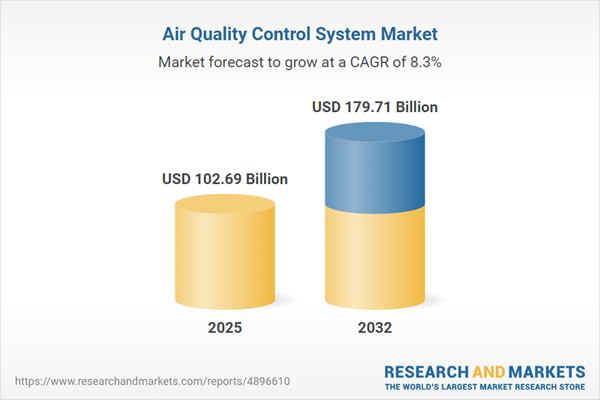Speak directly to the analyst to clarify any post sales queries you may have.
The air quality control system market is evolving swiftly as organizations target operational resilience, regulatory compliance, and sustainability across modern facilities. Senior leaders now prioritize solutions that proactively address changing mandates while supporting health, safety, and long-term business goals.
Market Snapshot: Air Quality Control System Market Overview
The air quality control system market is recording steady expansion, underpinned by expanded investment in advanced monitoring, filtration, and purification technologies. Rising urbanization is prompting more sectors—especially healthcare, manufacturing, and commercial real estate—to accelerate adoption of digital air quality management tools. These offerings help organizations navigate dynamic regulatory standards and increasingly complex operating environments. North America, Asia-Pacific, Europe, the Middle East, and Africa report growing demand for systems that integrate robustly with existing infrastructure, adapting efficiently to diverse compliance mandates. Solution providers are focusing on environmental performance, emphasizing integrated, flexible platforms for enterprises with multi-site operations.
Scope & Segmentation of the Air Quality Control System Market
This report equips procurement teams, risk managers, and regulatory compliance leaders with actionable insights for strategic resource planning and agile operational management in the air quality control system market.
- Product Types: Integrated air purifiers, standalone purification units, fixed and portable monitoring devices, dehumidifiers, humidifiers, and tailored ventilation solutions for varied installation requirements such as overhead, underfloor, duct, or rooftop applications.
- Technologies: Activated carbon filtration, high-efficiency particulate air (HEPA) filters including H13 and true HEPA, ion generation systems supporting both positive and negative ionization, and multiple wavelengths of ultraviolet purification (UV-A, UV-B, and UV-C) to support targeted airborne risk mitigation.
- Applications: Used in commercial buildings, healthcare facilities, industrial operations, and private residences to facilitate regulatory compliance and maintain high air quality in sensitive or high-traffic settings.
- End Users: Designed for hospitality providers, healthcare organizations, residential users, industrial sites, and office complexes to support operational aims and evolving policy requirements.
- Distribution Channels: Solutions are procured through direct sales, authorized distributors, specialist retailers, supermarkets, and e-commerce channels, offering acquisition options that scale with organizational needs.
- Regions & Markets: Implementation patterns are shaped by regulatory and infrastructure developments in the United States, Canada, Brazil, Europe, the Middle East, Africa, and Asia-Pacific, including China, India, Japan, and Australia. Regional diversity influences both product customization and how services are delivered.
- Key Companies: Leading vendors such as Daikin Industries, Carrier Global Corporation, Johnson Controls, Trane Technologies, Honeywell International, Mitsubishi Electric, Lennox International, LG Electronics, Panasonic, and Sharp Corporation provide scalable solutions tailored to sector-specific demands.
Key Takeaways for Senior Decision-Makers
- Deploying advanced air quality control systems supports resilience and reduces regulatory and operational risks, helping organizations maintain compliance in evolving environments.
- Integration of IoT-enabled monitoring and next-generation sensors delivers immediate insights, allowing facilities to optimize management and respond to regulatory updates in real time.
- Continuous innovation in filtration and purification raises health and safety standards, protecting both workforce and customers in sensitive locations and high-traffic public spaces.
- Streamlined procurement processes and integrated oversight simplify system sourcing and management, improving operational efficiency for organizations with distributed or multi-site properties.
- Urban growth and the introduction of new sustainability mandates necessitate adaptable air quality control platforms to meet strict standards and organization-wide objectives.
Tariff Impact and Global Supply Chain Dynamics
Shifts in United States tariffs have altered cost structures for air quality control systems that rely on imported components. Organizations are reacting by diversifying their supplier base, revising manufacturing locations, and prioritizing regional procurement strategies. Amid continuing supply chain disruptions, digital management platforms increase continuity and support agile responses to global market changes.
Methodology & Data Sources
This report draws on direct interviews with industry executives and is enhanced by secondary research involving regulatory audit reviews, financial data analysis, patent assessments, and stakeholder discussions. The combined approach ensures an actionable framework for the air quality control system market.
Why This Report Matters for the Air Quality Control System Market
- Facilitates effective segmentation and strategy development, enabling efficient procurement and increased adaptability in response to shifting regulations.
- Guides technology adoption and regional planning, helping organizations govern operations in varied regulatory settings.
- Assists leaders in managing complex supply chain and compliance concerns, streamlining decision-making across diverse and geographically dispersed portfolios.
Conclusion
Integrating advanced air quality control systems enables organizations to meet compliance standards, minimize risks, and achieve long-term objectives as operational and regulatory landscapes continue to change.
Additional Product Information:
- Purchase of this report includes 1 year online access with quarterly updates.
- This report can be updated on request. Please contact our Customer Experience team using the Ask a Question widget on our website.
Table of Contents
3. Executive Summary
4. Market Overview
7. Cumulative Impact of Artificial Intelligence 2025
Companies Mentioned
The companies profiled in this Air Quality Control System market report include:- Daikin Industries, Ltd.
- Carrier Global Corporation
- Johnson Controls International PLC
- Trane Technologies PLC
- Honeywell International Inc.
- Mitsubishi Electric Corporation
- Lennox International Inc.
- LG Electronics Inc.
- Panasonic Corporation
- Sharp Corporation
Table Information
| Report Attribute | Details |
|---|---|
| No. of Pages | 186 |
| Published | November 2025 |
| Forecast Period | 2025 - 2032 |
| Estimated Market Value ( USD | $ 102.69 Billion |
| Forecasted Market Value ( USD | $ 179.71 Billion |
| Compound Annual Growth Rate | 8.3% |
| Regions Covered | Global |
| No. of Companies Mentioned | 11 |









